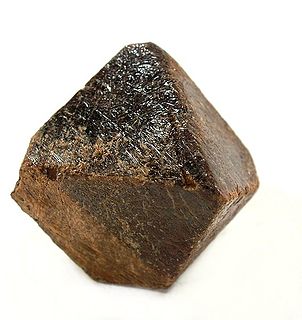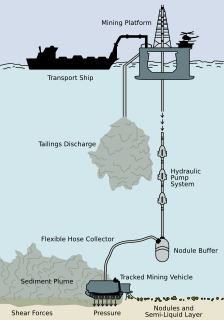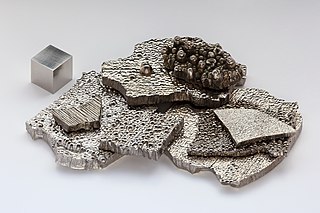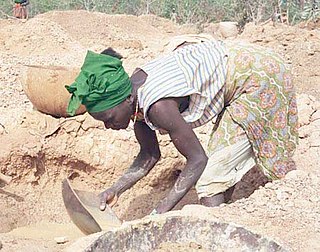
Ore is natural rock or sediment that contains one or more valuable minerals, typically containing metals, that can be mined, treated and sold at a profit. Ore is extracted from the earth through mining and treated or refined, often via smelting, to extract the valuable metals or minerals. The grade of ore refers to the concentration of the desired material it contains. The value of the metals or minerals a rock contains must be weighed against the cost of extraction to determine whether it is of sufficiently high grade to be worth mining, and is therefore considered an ore.

Tantalum is a chemical element with the symbol Ta and atomic number 73. Previously known as tantalium, it is named after Tantalus, a villain from Greek mythology. Tantalum is a rare, hard, blue-gray, lustrous transition metal that is highly corrosion-resistant. It is part of the refractory metals group, which are widely used as minor components in alloys.

Coltan is a dull black metallic ore from which the elements niobium and tantalum are extracted. The niobium-dominant mineral in coltan is columbite, and the tantalum-dominant mineral is the tantalite.

Pyrochlore2Nb2O6(OH,F) is a mineral group of the niobium end member of the pyrochlore supergroup. The general formula, A2B2O7, represent a family of phases isostructural to the mineral pyrochlore. Pyrochlores are an important class of materials in diverse technological applications such as luminescence, ionic conductivity, nuclear waste immobilization, high temperature thermal barrier coatings, automobile exhaust gas control, catalysts, solid oxide fuel cell, ionic/electrical conductors etc.
Anglo American plc is a British listed multinational mining company with headquarters in London, England. It is the world's largest producer of platinum, with around 40% of world output, as well as being a major producer of diamonds, copper, nickel, iron ore and metallurgical and thermal coal. The company has operations in Africa, Asia, Australia, Europe, North America and South America.

Deep sea mining is a growing subfield of experimental seabed mining that involves the retrieval of minerals and deposits from the ocean floor found at depths of 200 meters or greater. As of 2021, the majority of marine mining efforts are limited to shallow coastal waters only, where sand, tin and diamonds are more readily accessible. There are three types of deep sea mining that have generated great interest: polymetallic nodule mining, polymetallic sulphide mining, and the mining of cobalt-rich ferromanganese crusts. The majority of proposed deep sea mining sites are near of polymetallic nodules or active and extinct hydrothermal vents at 1,400 to 3,700 metres below the ocean’s surface. The vents create globular or massive sulfide deposits, which contain valuable metals such as silver, gold, copper, manganese, cobalt, and zinc. The deposits are mined using either hydraulic pumps or bucket systems that take ore to the surface to be processed.

The mining industry of the Democratic Republic of the Congo plays a significant role in the world's supply of cobalt, copper, diamond, tantalum, tin, gold and produces over 70% of globally produced cobalt. It is the Democratic Republic of the Congo's largest source of export income.

China Molybdenum Company Limited, previously known as Luoyang Luanchuan Molybdenum Limited (洛阳栾川钼业) is the largest molybdenum producer in Mainland China and top 5 in the world listed in the Hong Kong Stock Exchange and Shanghai Stock Exchange. It is one of the largest tungsten producers in the world, and is the second largest Cobalt and Niobium Producer and the leading Copper producer worldwide. The headquarters of the company is at Luanchuan County, Luoyang City, Henan Province. The chairman is Yuan Honglin (袁宏林), elected in June 2020. The two largest shareholders of the company are the Cathay Fortune Group associated with billionaire Yu Yong, and the state-owned Luoyang Mining Group (LMG).
China Minmetals Corporation is a Chinese metals and mineral trading company headquartered in Beijing. It is a state-owned corporation under direct supervision of the State-owned Assets Supervision and Administration Commission (SASAC). China Minmetals is engaged in the production and trading of metals and minerals, including copper, aluminum, tungsten, tin, antimony, lead, zinc, and nickel.

The following outline is provided as an overview of and topical guide to mining:

Mining in the United Kingdom produces a wide variety of fossil fuels, metals, and industrial minerals due to its complex geology. In 2013, there were over 2,000 active mines, quarries, and offshore drilling sites on the continental land mass of the United Kingdom producing £34bn of minerals and employing 36,000 people.
The Buena Vista Mine is located 21 miles (34 km) south of Lovelock, Nevada. In the past, the area has been known as the Mineral Basin, though another name for the area has been the Buena Vista District. There are at least two other Buena Vista Mining Districts in Nevada, one is located near Unionville, Nevada, the other located in Esmeralda and Mineral counties near the California border. The nearby Buena Vista Hills are named for the mine. The district encompasses roughly 21 square miles (54 km2) of mineral and surface rights, and is one of the largest un-mined iron ore resources in the western United States.
Thor Lake is a deposit of rare metals located in the Blachford Lake intrusive complex. It is situated 5 km north of the Hearne Channel of Great Slave Lake, Northwest Territories, Canada, approximately 100 kilometers east-southeast of the capital city of Yellowknife. Geologically located on the Canadian Shield it is mostly composed of peralkaline syenite. The Blatchford Lake complex was created in the early Proterozoic, 2.14 Ga ago. The deposit is divided in several sub-structures. In a small zone at the northern edge of the syenite, the T-Zone, minerals like bastnäsite, phenakite and xenotime can be found.
The Citronen mine is one of the largest potential lead and zinc mines in Greenland. The mine is located in Citronen Fjord, Northern Greenland. The mine has reserves amounting to 100 million tonnes of ore grading 2% lead and 3% zinc.
Kayelekera uranium mine is an open cast uranium mine 52 kilometers west of the regional administrative and commercial centre Karonga in Malawi, Africa and was the country's largest mine. Production at the mine has been paused since February 2014, due to a fall in global uranium prices.

The mining industry of Guinea was developed during colonial rule. The minerals extracted consisted of iron, gold, diamond, and bauxite. Guinea ranks first in the world in bauxite reserves and 6th in the extraction of high-grade bauxite, the aluminium ore. The mining industry and exports of mining products accounted for 17% of Guinea's gross domestic product (GDP) in 2010. Mining accounts for over 50% of its exports. The country accounts for 94% of Africa's mining production of bauxite. The large mineral reserve, which has mostly remained untapped, is of immense interest for international firms.

The mining industry of Malawi, includes a number of gemstones and other minerals.
Mzuzu Warriors Football Club is a Malawian football (soccer) club based in Mzuzu, Northern Region, currently playing in the TNM Super League, the top division of Malawian football.
The Bwengu Solar Power Station is a 50 megawatts solar power plant, under construction in Malawi. The power station is under development by a consortium led by Quantel Renewable Energy, an independent power producer (IPP), based in the United States. Construction began in February 2022, with commercial commissioning expected in the first quarter of 2023. The energy generated at this solar farm is expected to be sold to the Electricity Supply Corporation of Malawi (ESCOM), under a long-term power purchase agreement (PPA).
The Boa Vista mine is an open pit niobium and phosphate mine located near the city of Catalão in Goiás state in Brazil. Geologically, it is located on the Catalão II carbonatite complex.











